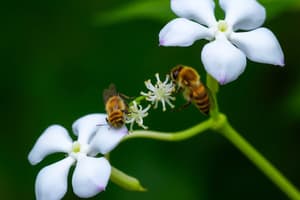Podcast
Questions and Answers
What is the primary role of the stamen in flowering plants?
What is the primary role of the stamen in flowering plants?
- To produce pollen (correct)
- To form the zygote
- To develop into a fruit
- To produce ovules
Which process is involved in the formation of female gametes in flowering plants?
Which process is involved in the formation of female gametes in flowering plants?
- Pollination
- Microsporogenesis
- Fertilization
- Megasporogenesis (correct)
What occurs immediately after pollen germination on the stigma?
What occurs immediately after pollen germination on the stigma?
- Zygote formation
- Endosperm development
- Pollen tube formation (correct)
- Seed development
During double fertilization, what happens to the second sperm cell?
During double fertilization, what happens to the second sperm cell?
What happens to the zygote after fertilization in flowering plants?
What happens to the zygote after fertilization in flowering plants?
What is a significant benefit of sexual reproduction in flowering plants?
What is a significant benefit of sexual reproduction in flowering plants?
Which part of the flower is responsible for receiving pollen during pollination?
Which part of the flower is responsible for receiving pollen during pollination?
What typically encases the seeds after fertilization in flowering plants?
What typically encases the seeds after fertilization in flowering plants?
Which of the following terms describes the transfer of pollen to the stigma?
Which of the following terms describes the transfer of pollen to the stigma?
What is formed as a result of the fertilization of the egg cell?
What is formed as a result of the fertilization of the egg cell?
Study Notes
Introduction to Sexual Reproduction in Flowering Plants
- Sexual reproduction involves the fusion of gametes to form a zygote.
- Flowering plants (angiosperms) have specialized structures for this process.
Key Structures
-
Flower Parts:
- Stamen: Male reproductive part; consists of anther (produces pollen) and filament.
- Pistil: Female reproductive part; consists of ovary (contains ovules), style, and stigma.
-
Pollination:
- Transfer of pollen from anther to stigma.
- Can be biotic (insects, birds) or abiotic (wind, water).
Gamete Formation
- Microsporogenesis: Formation of male gametes (pollen grains) in anthers.
- Megasporogenesis: Formation of female gametes (ovules) in ovaries.
Fertilization Process
- Pollen Germination: Pollen grain germinates on stigma.
- Pollen Tube Formation: Pollen tube grows down the style towards the ovary.
- Sperm Cell Delivery: Two sperm cells travel through the pollen tube.
- Double Fertilization:
- One sperm fertilizes the egg cell (forming a zygote).
- The other sperm fuses with two polar nuclei (forming triploid endosperm).
Seed and Fruit Development
- Zygote Development: Zygote develops into an embryo within the ovule.
- Endosperm Formation: Provides nourishment to the developing embryo.
- Ovary Transformation: The ovary develops into a fruit, encasing the seeds.
Importance of Sexual Reproduction
- Genetic Diversity: Increases variation within plant populations.
- Adaptation: Enhances survival and adaptability to changing environments.
Summary
- Sexual reproduction in flowering plants involves complex structures and processes, including pollination, gamete formation, fertilization, and seed development.
- Critical for the propagation of species and maintaining biodiversity.
Introduction to Sexual Reproduction in Flowering Plants
- Sexual reproduction is the fusion of male and female gametes, resulting in a zygote.
- Angiosperms, or flowering plants, are uniquely equipped with structures to facilitate reproduction.
Key Structures
-
Flower Parts:
- Stamen: The male organ of the flower; includes an anther (where pollen is produced) and a filament.
- Pistil: The female organ; consists of the ovary (housing ovules), style, and stigma.
-
Pollination:
- The transfer of pollen from the stamen to the stigma, crucial for fertilization.
- Can occur via biotic vectors (insects, birds) or abiotic means (wind, water).
Gamete Formation
-
Microsporogenesis:
- The process within anthers that produces male gametes, known as pollen grains.
-
Megasporogenesis:
- The formation of female gametes contained within the ovules in the ovaries.
Fertilization Process
-
Pollen Germination:
- Initiated upon pollination when a pollen grain activates on the stigma.
-
Pollen Tube Formation:
- The pollen grain develops a tube that extends down the style toward the ovary.
-
Sperm Cell Delivery:
- Two sperm cells are transported through the pollen tube to reach the ovule.
-
Double Fertilization:
- One sperm fertilizes the egg cell forming a diploid zygote.
- The other sperm fuses with two polar nuclei, creating the triploid endosperm, which nourishes the zygote.
Seed and Fruit Development
-
Zygote Development:
- After fertilization, the zygote develops into an embryo within the ovule.
-
Endosperm Formation:
- Endosperm forms to provide essential nutrients for the developing embryo.
-
Ovary Transformation:
- The ovary matures into a fruit, which encases the seeds, facilitating their dispersal.
Importance of Sexual Reproduction
-
Genetic Diversity:
- Sexual reproduction increases variability, providing a broader genetic pool.
-
Adaptation:
- Enhances plant adaptability, aiding in survival and resilience against environmental changes.
Summary
- The process of sexual reproduction in flowering plants entails intricate mechanisms from pollination to the generation of seeds and fruits.
- Vital for the propagation of plant species and the preservation of biodiversity across ecosystems.
Studying That Suits You
Use AI to generate personalized quizzes and flashcards to suit your learning preferences.
Description
Explore the fascinating processes of sexual reproduction in flowering plants. This quiz covers key structures such as stamen and pistil, the role of pollination, and the stages of gamete formation leading to fertilization. Perfect for students of botany and plant biology!


